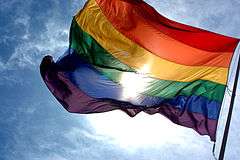Heteroflexibility
| Bisexuality topics |
|---|
| Related sexual orientations |
| Sexual identities |
| Studies |
| Attitudes and discrimination |
| Bisexual community |
| Lists |
| Portals |
|
Heteroflexibility is a form of a sexual orientation or situational sexual behavior characterized by minimal homosexual activity in an otherwise primarily heterosexual orientation that is considered to distinguish it from bisexuality. It has been characterized as "mostly straight".[1] Although sometimes equated with bi-curiosity to describe a broad continuum of sexual orientation between heterosexuality and bisexuality,[2] other authors distinguish heteroflexibility as lacking the "wish to experiment with ... sexuality" implied by the bi-curious label.[3] The corresponding situation in which homosexual activity predominates has also been described, termed homoflexibility.[4]
National surveys in the U.S. and Canada show that 3 to 4 percent of male teenagers, when given the choice to select a term that best describes their sexual feelings, desires, and behaviors, opt for "mostly" or "predominantly" heterosexual. With "100% heterosexual" being the largest assumed identity, "mostly-heterosexual" was the first runner up in self-identification.[5] Of the 160 men interviewed for a study in 2008 and 2009, nearly one in eight reported same-sex attractions, fantasies, and crushes. The majority had these feelings since high school; a few others developed them more recently. And in a national sample of young men whose average age was 22, the "mostly straight" proportion increased when they completed the same survey six years later. An even higher percentage of post-high-school young-adult men in the U.S. and in a handful of other countries (including New Zealand and Norway) make the same choice.[6]
As of 2010, most studies of heteroflexibility have focused on young men and women, especially white women in the college environment.[7] Research suggesting the influence of prenatal androgen exposure on female sexual identity places heteroflexibility on a continuum with bisexuality and lesbianism.[8] Other studies have focused on social origins for the behavior, such as the shifting media presentation of bisexuality or the "socialization of the male interloper fantasy" in which a man is invited into a lesbian relationship as a third partner.[9][10][11][12]
Unlike "bisexual until graduation" and similar pejoratives, heteroflexibility is typically considered to have a positive connotation, and is often a self-applied label, although use of the term as a pop-culture slur has been attested.[13]
See also
References
- ↑ Thompson, E.M.; Morgan, E.M. (2008). ""Mostly straight" young women: Variations in sexual behavior and identity development". Developmental Psychology. 44 (1): 15–21. doi:10.1037/0012-1649.44.1.15. PMID 18194001.
- ↑ Frank, Katherine (2008). "'Not Gay, but Not Homophobic': Male Sexuality and Homophobia in the 'Lifestyle'". Sexualities. 11 (4): 435–454. doi:10.1177/1363460708091743.
- ↑ Smorag, Pascale (14 May 2008). "From Closet Talk to PC Terminology : Gay Speech and the Politics of Visibility". Transatlantica. Retrieved 21 October 2010.
- ↑ Keppel, Bobbi (2006). "Affirmative Psychotherapy with Older Bisexual Women and Men". Journal of Bisexuality. 6 (1–2): 85–104. doi:10.1300/J159v06n01_06.
- ↑ Savin-Williams, Ritch C., Kara Joyner, and Gerulf Rieger. "Prevalence and stability of self-reported sexual orientation identity during young adulthood."Archives of sexual behavior 41.1 (2012): 103-110.
- ↑ "Mostly Straight, Most of the Time". goodmenproject. 2010-11-03. Retrieved 2011-01-30.
- ↑ Ambrose, Emily (2009). "Heteroflexibility: Bending the Existing Label Triangle". Colorado State University Journal of Student Affairs (43): 69–75.
- ↑ Ciumas, C.; Hirschberg, A. Lindén; Savic, I. (2008). "High Fetal Testosterone and Sexually Dimorphic Cerebral Networks in Females". Cerebral Cortex. 19 (5): 1167–1174. doi:10.1093/cercor/bhn160. PMID 18854582.
- ↑ Diamond, L.M. (2005). ""I'm straight, but I kissed a girl": The trouble with American media representations of female-female sexuality". Feminism & Psychology (15): 104–110.
- ↑ Siegel, Karolynn; Schrimshaw, Eric W.; Lekas, Helen-Maria; Parsons, Jeffrey T. (2008). "Sexual Behaviors of Non-gay Identified Non-disclosing Men Who Have Sex with Men and Women". Archives of Sexual Behavior. 37 (5): 720–735. doi:10.1007/s10508-008-9357-6. PMID 18506616.
- ↑ Hubbard, Phil (2008). "Here, There, Everywhere: The Ubiquitous Geographies of Heternormativity". Geography Compass. 2 (3): 640–658. doi:10.1111/j.1749-8198.2008.00096.x.
- ↑ Is The Male Lesbian Fantasy Messing With Women’s Sexuality?. Simcha. 2009.
- ↑ Zaylía, Jessica Leigh (2009). "Toward a Newer Theory of Sexuality: Terms, Titles and the Bitter Taste of Bisexuality". Journal of Bisexuality. 9 (2): 109–123. doi:10.1080/15299710902881467.
Further reading
- Blow, Charles M. (June 4, 2010). "Gay? Whatever, Dude". The New York Times.
